
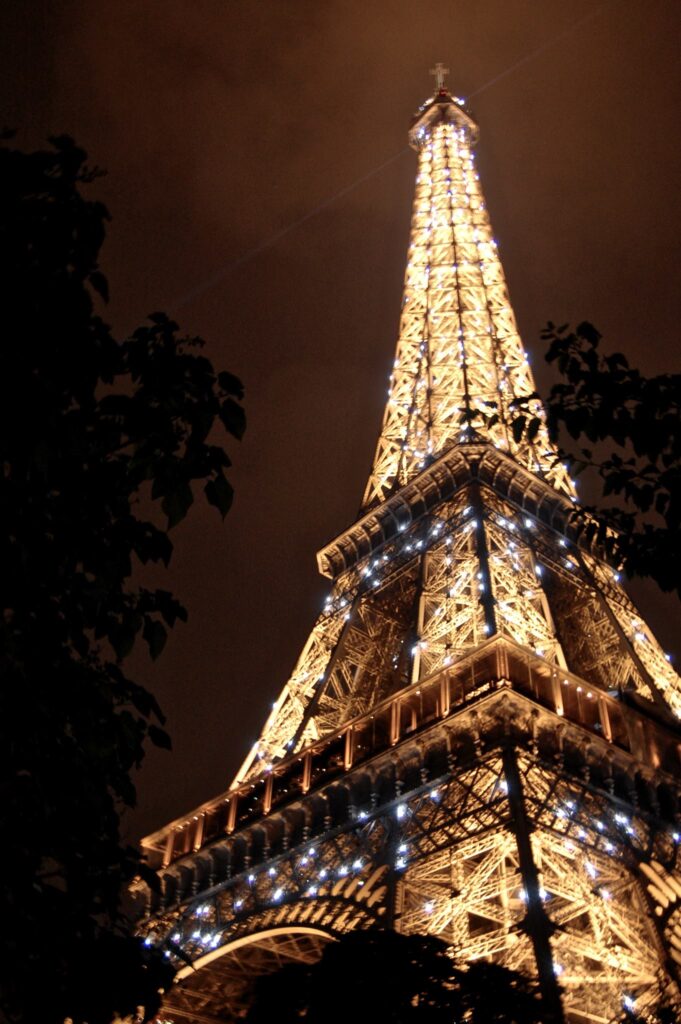
Paris is a city that attracts old souls- romantics whose hearts ache for a time in which they weren’t even born.
A sip of absinthe in Montparnasse or cafe in a smoke-filled brasserie in Montmartre will transport the modern-day traveler to a time when the City of Light captivated artists and writers of the lost generation.
“If you are lucky enough to have lived in Paris as a young man, then wherever you go for the rest of your life, it stays with you, for Paris is a moveable feast,” author Ernest Hemingway famously said.
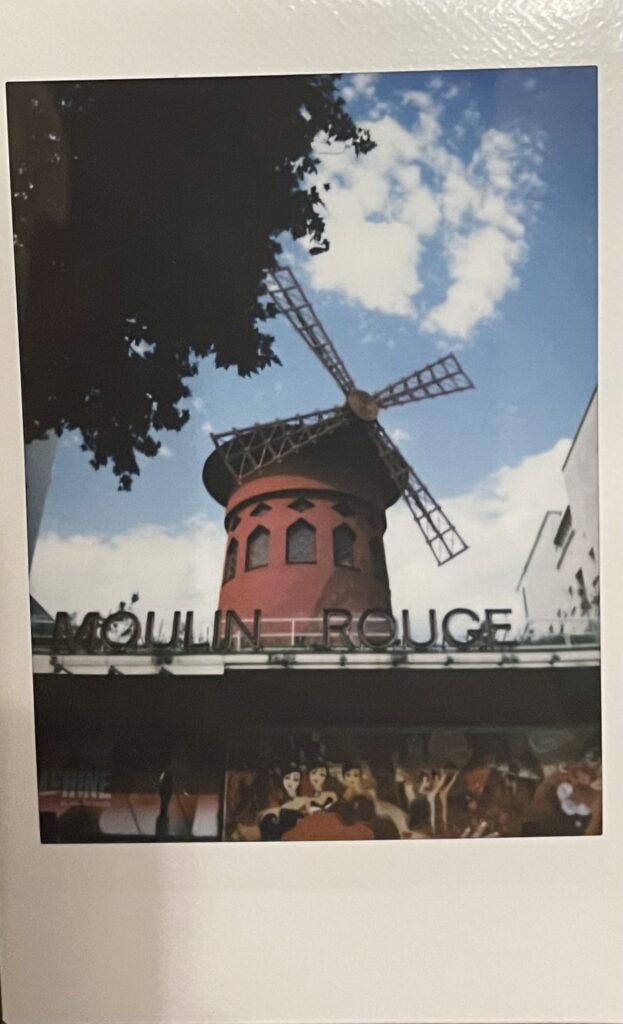

Portrait by Kesnia Paris Photo
Paris in the early 20th century was a time in which the world embraced change. The city was at the center of international innovations, including the Eiffel Tower, Paris Metro system, and iconic monuments such as the Grand Palais, Petit Palais, and the Pont Alexandre III. Burlesque, cabaret and art movements such as impressionism and fauvism were turning tradition on its head. Paris’s heart was beating at an unprecedented pace. To be at its center was to feel alive.
Paris’s cobblestones bear the footsteps of millions of passers-by, who have left their own unique stories behind. One does not need to wander far to peer into the city’s past.
Bouillon Julien
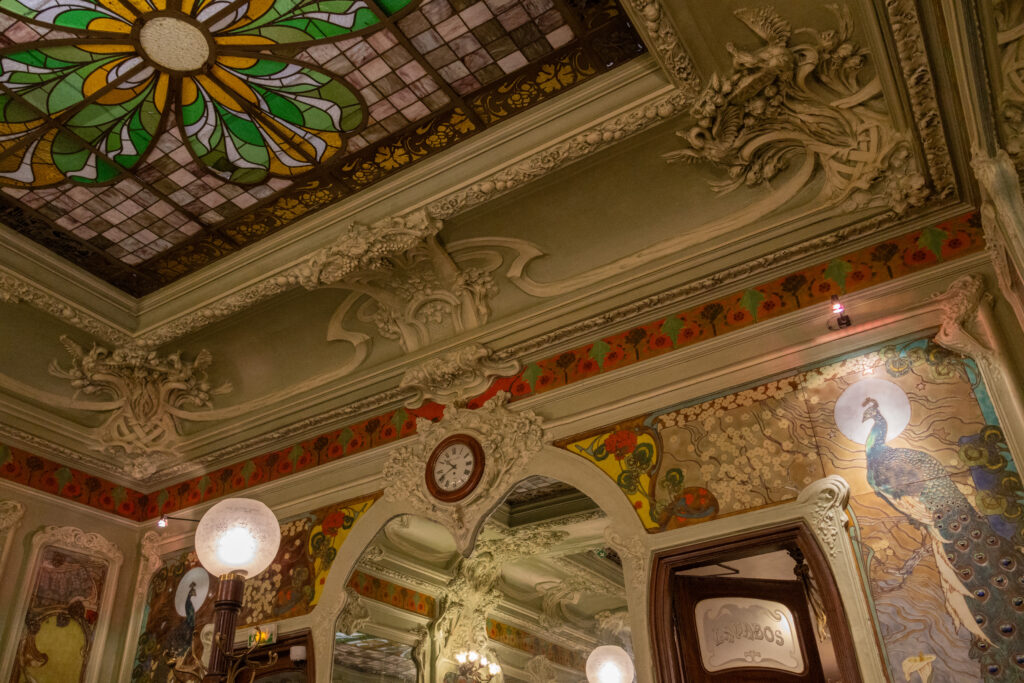
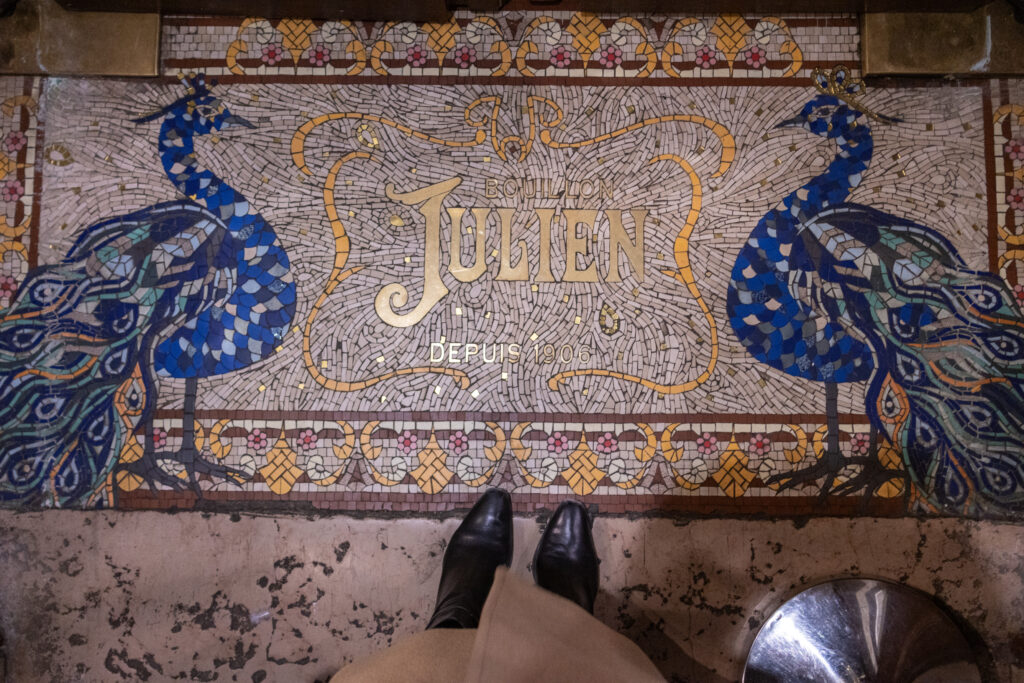
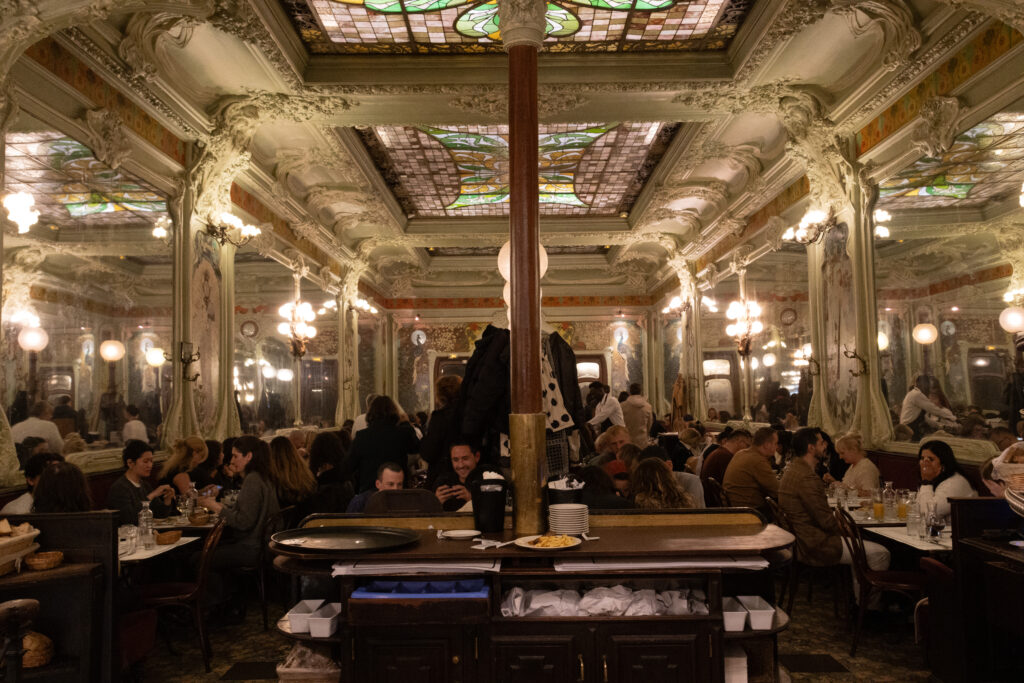

Legend has it that French singer Édith Piaf was once Queen of Bouillon Julien. Adorning France with hits such as “La Vie en Rose”, la môme Piaf reportedly sat at table number 24.
The seafoam green interiors and mahogany bar were opened to the public in 1906 as a bouillon, a particularly Parisian concept of serving traditional French cuisine such as deviled eggs, leek vinaigrette, snails, or veal stew at an affordable price. The bouillon is said to be France’s first instance of a chain restaurant. The first opened in 1854 by butcher Adolphe-Baptiste Duval, offering a single meat dish with broth to workers at the Les Halles market. The hearty soups and stews were a healthy alternative to nearby restaurants of the time, which, according to Le Monde1, often covered expired meat in savory sauces. The concept of being “bon et pas cher” infiltrated Paris faster than the plague, with approximately 250 Bouillon Duval taking hold in 1900.
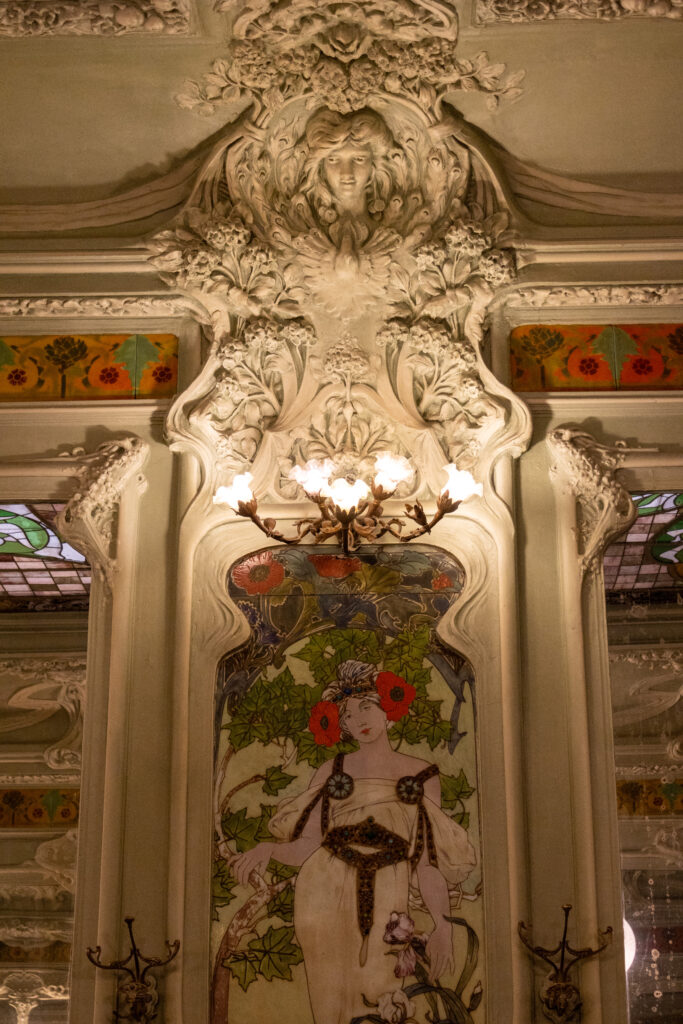
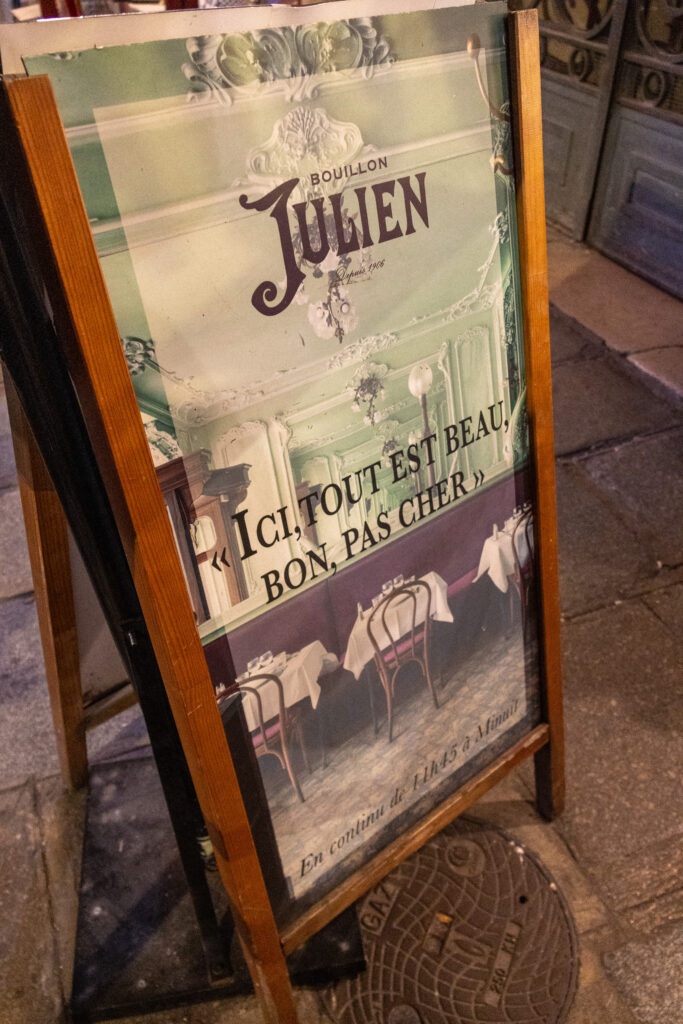
The popularity of Bouillon Julien is evident, with an hour-long queue on Saturday evening. We are called to cross over the peacock mosaic and enter beyond the velvet curtains, protecting us from the bitter November wind. The scene is beautifully chaotic, with servers pacing quickly down two aisles outlined by wooden tables of clients sitting shoulder-to-shoulder. The sounds of conversations in French, Spanish, English and Russian carry throughout the Art Nouveau room into one melodic hum.
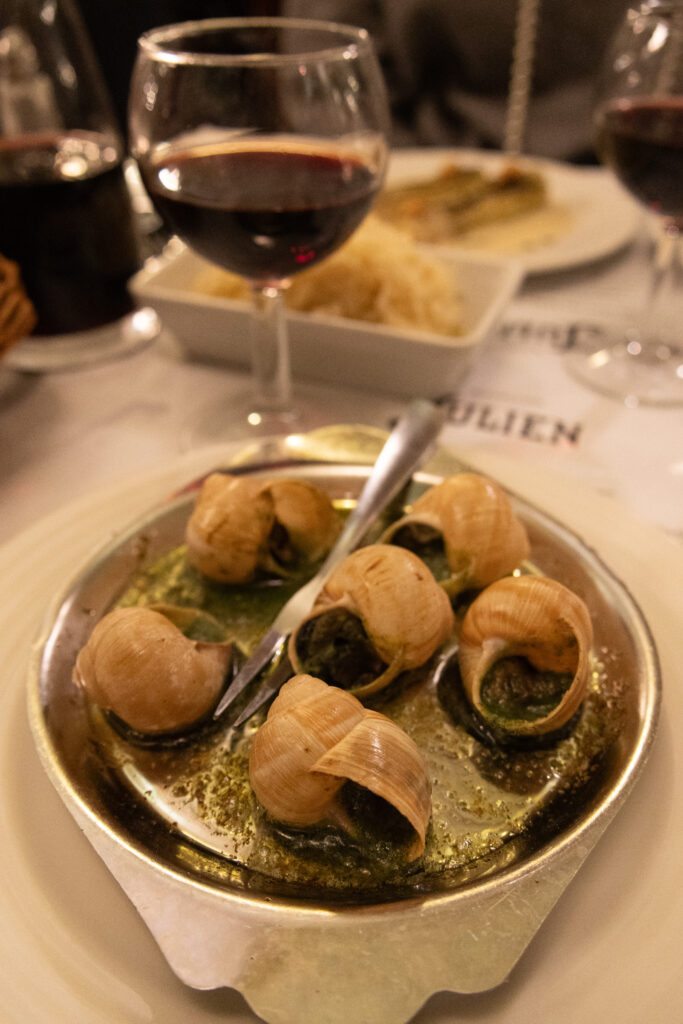
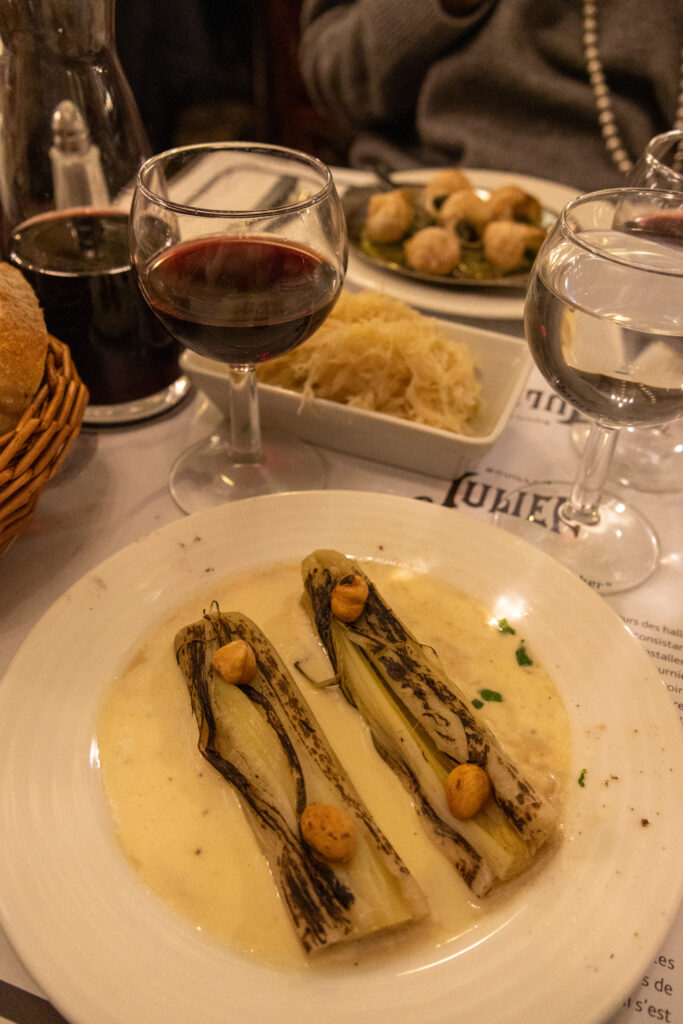
As someone who grew up dreaming of Paris and learning the language from French New Wave artists such as France Gall and Françoise Hardy, I had yet to experience the epitome of the French culinary experience: snails. What was once served to the poor during the Middle Ages is now considered a luxurious delicacy. In France, snails are often reserved for special celebrations, and are a typical find in French Christmas markets.
My first snail was hidden deep within its shell beneath a heaping pile of butter, garlic, and parsley. In fact, without thinking, I quite enjoyed it. When the rubbery texture of the snail finally made its way to my tastebuds, psychology got the better of me, and that delightful feeling of the thick buttery goodness experienced five seconds prior turned into the horrific realization of what I was eating. I imagined Ron Weasley being cast under a slug vomiting spell in Harry Potter (if you know, you know), and quickly washed down the black mollusk with a glass of Burgundy.
Nevertheless, I would thoroughly give it a second try.
Cabaret at the Crazy Horse

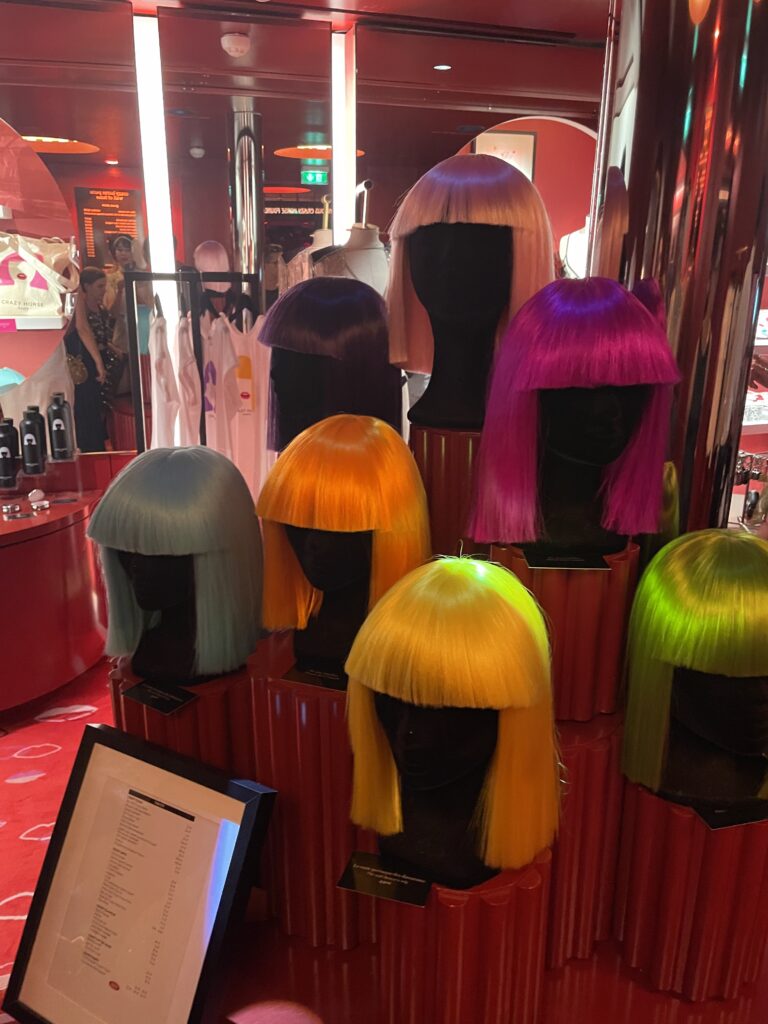
Tucked behind the Champs Elysée is a cabaret theater easily identified by a set of full red lit up lips on its exterior. The intimate space of 230 ruby red velvet cushioned seats is dimly lit beneath a red light, accompanied by pink champagne bottles.
As the curtains part, 12 professional dancers dressed in Royal Horse Guards uniforms, exposing breasts and long legs, begin to march. The act entitled “God Save Our Bare Skin” has been the theater’s opening since 1989. The choreography draws from authentic steps of the Royal Guard, of which one of Queen Elizabeth II’s officers traveled to Paris to support in the shaping of the act.
“Wow!” my Wisconsin-based friend Amber exclaimed upon seeing the dancers in uniform. “Well, you surely won’t see that in America!”

Henri de Toulouse-Lautrec
Panneau pour la baraque de la Goulue, à la Foire du Trône à Paris, 1895
Musée d’Orsay
Cabaret is an integral part of Parisian Belle Époque, as captured in paintings of French Cancan dancers by Henri de Toulouse-Lautrec. Le Chat Noir in Montmartre is accredited with creating our modern sense of cabaret. After opening in 1881, it is said that Le Chat Noir was the first bar in Paris that began accompanying meals with performances with poetry, theatrical performances, and music. During the Belle Époque, Cabaret flourished in the neighborhoods of Montparnasse and the Latin Quarter, while Burlesque took off in Montmartre and Pigalle.
I found the Crazy Horse surprisingly empowering, as it seemed to pay tribute to all things sensual and feminine, without being vulgar. I was mystified by the act “Attitude”, showing ballerinas dancing in large rings with colorful lights dancing across their skin, resembling the inside of a kaleidoscope. Their jeweled headpieces reminded me of 1920s glamour.
Les Crazy Girls are professionally trained, dressed primarily in lights and shadows. In an interview with former Crazy Horse dancer Starlette O’Ara in this podcast, the professionally trained ballerina shared that dancers sign a contract noting that they will not gain or lose more than 2 kg (approximately 4 lbs) from their initial start weight. With two performances every night, and three on Saturdays, dancers must be disciplined. Stage director Svetlana Konstantinova shares in this interview that many dancers have strict classical ballet training, and need to “relearn dance” in an effort to “give their curves and sensuality the freedom to express themselves.”
Today, Parisian cabarets are no longer exclusive to artists in Pigalle and Montmartre, and have become a staple in tourist itineraries to the City of Love. Ahead of the 2024 Olympic Games in Paris, Crazy Horse dancer Jess Bennett gave free introductory cabaret dance lessons to the public. Curious to try cabaret, I joined a class at the Secret Follies dance school taught by a former Crazy Horse dancer in Switzerland. The emphasis on creating angles with the body strongly contrasted with the work towards a linear alignment in ballet. To my surprise, the other students seemed just as shy as I was to stand towards the front of the floor, or to completely release all accumulated tension. If dance could help gain self-confidence, would that carry off stage?
Mondaine de Pariso
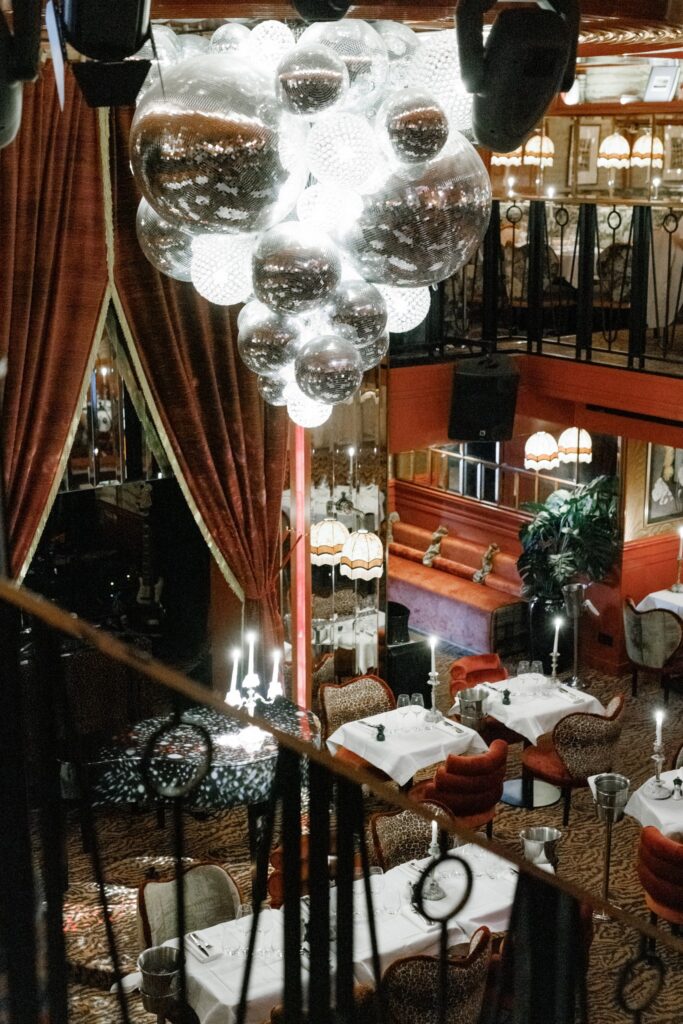
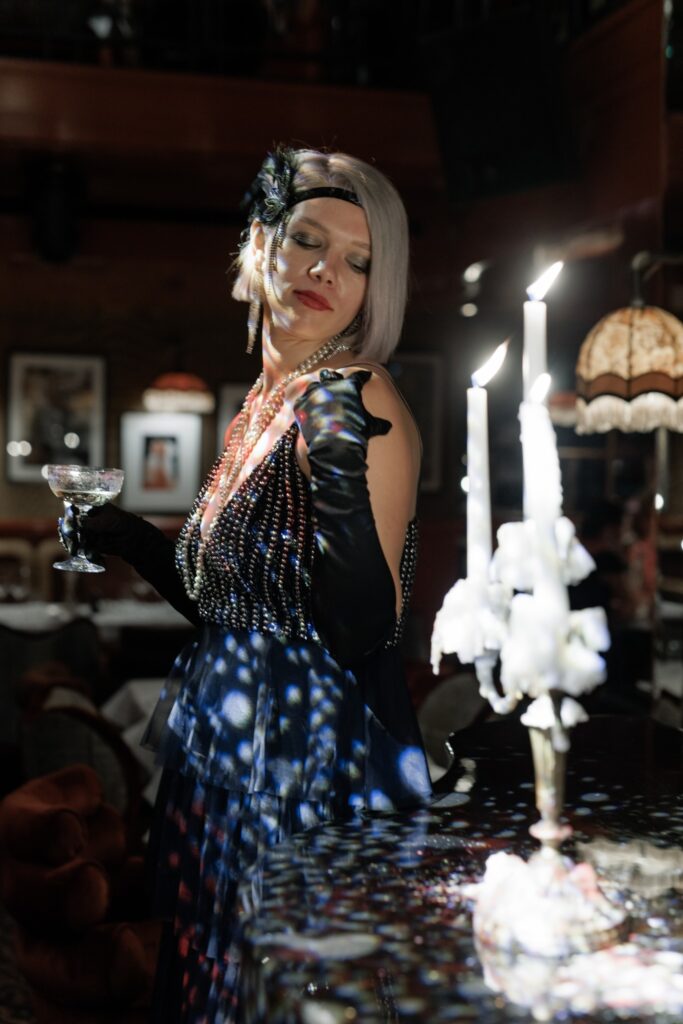
Photos by Kesnia Paris Photo
Mondaine de Pariso is a coveted watering hole for Instagram influencers. Opened in 2022, the restaurant is relatively new to the Parisian dining scene. Unlike Bouillon Julien or le Train Bleu, the restaurant does not draw in large crowds in part to its 20th century roots.

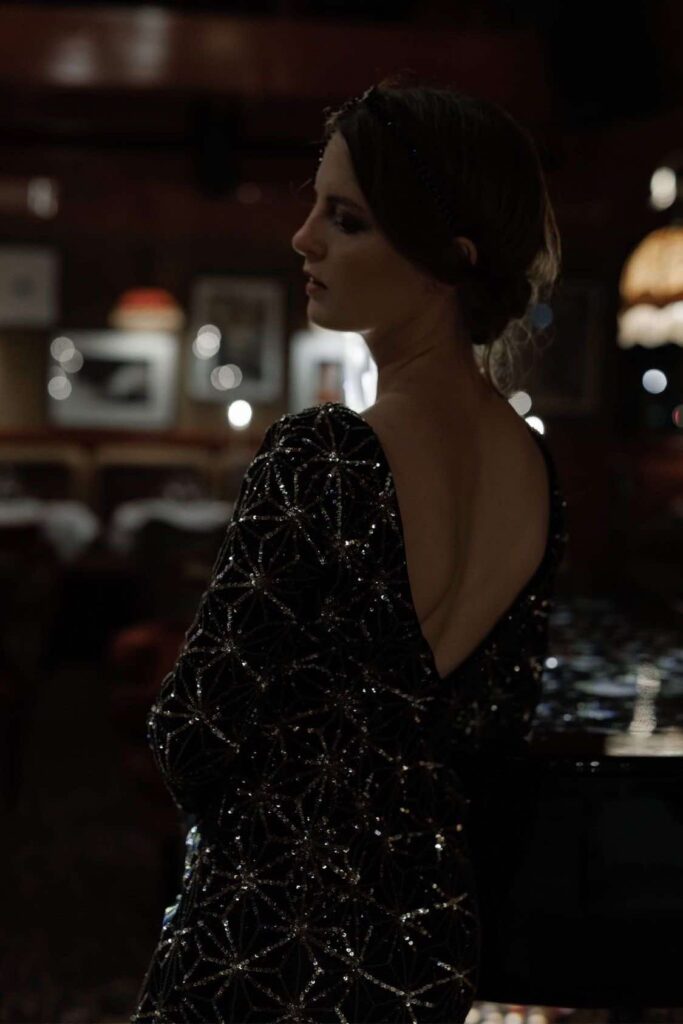
Portraits by Kesnia Paris Photo
Designer Daphné Desjeux envisioned an affluent young woman, perhaps an artist, throwing massive parties in her luxurious Parisian apartment. While the décor is more David Bowie and Serge Gainsbourg rather than Anaïs Nin, I couldn’t help but imagine the glitz and glamour of parties organized by Gatsby. The restaurant is dark lit, illuminated in soft pinks and emerald tones. Leopard print bar stools and vintage champagne glasses beckon the beautiful to toast in close corridors. A smoke room reminds me of the early 2000s, with remnants of secondhand smoke hanging in the air. Wax candlesticks are placed upon a baby grand piano, with performances each night by singers adorned in feathers and sequins, reminiscent of early Parisian cabaret.
Le Train Bleu

I’ve always dreamt of traveling on the Orient Express or along the Trans-Siberian Railway. To celebrate my birthday last August, we took a ride on Switzerland’s GoldenPass Belle Époque train from Montreux to Zweisimmen.
For years I lugged heavy bags and rolled dirty-wheeled suitcases through Paris’s Gare de Lyon railway station. Little did I know that that beyond the concrete walls was a staircase in Hall 2 leading up to a restaurant fit for a novel.
Le Train Bleu looks like the inside of a music box. It’s sugar and spice and everything nice- a figment of every little girl’s princess fairytale. It gives travelers a peak into the ornate architecture that fills every crack and cranny within the city before them. A glimpse into the underbelly of the Louvre. A bite of luxury, without the pretentious aftertaste.
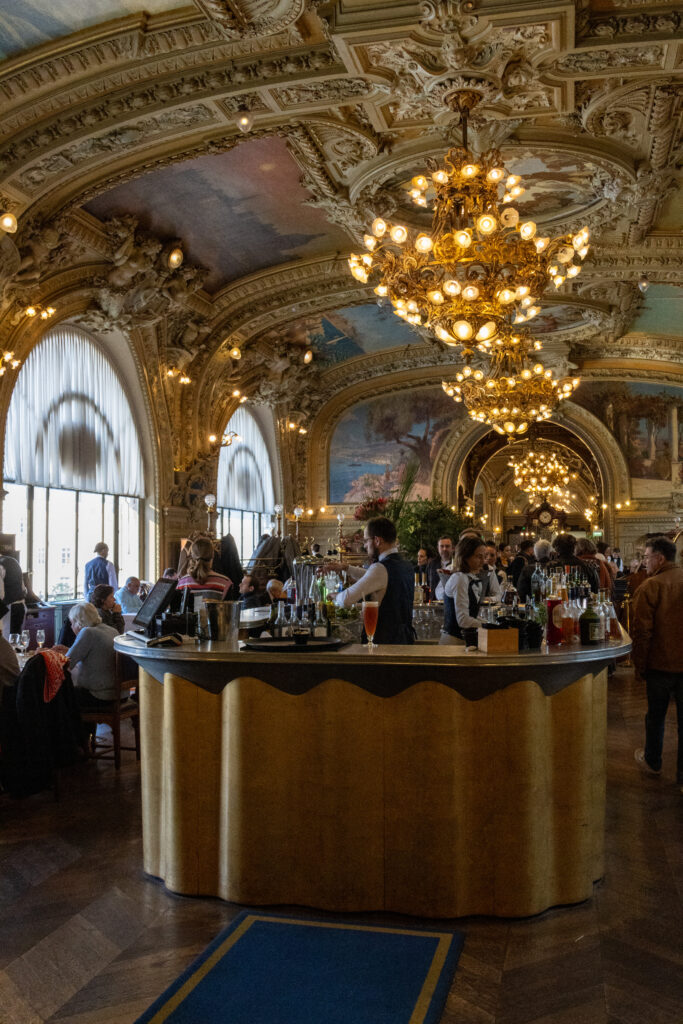
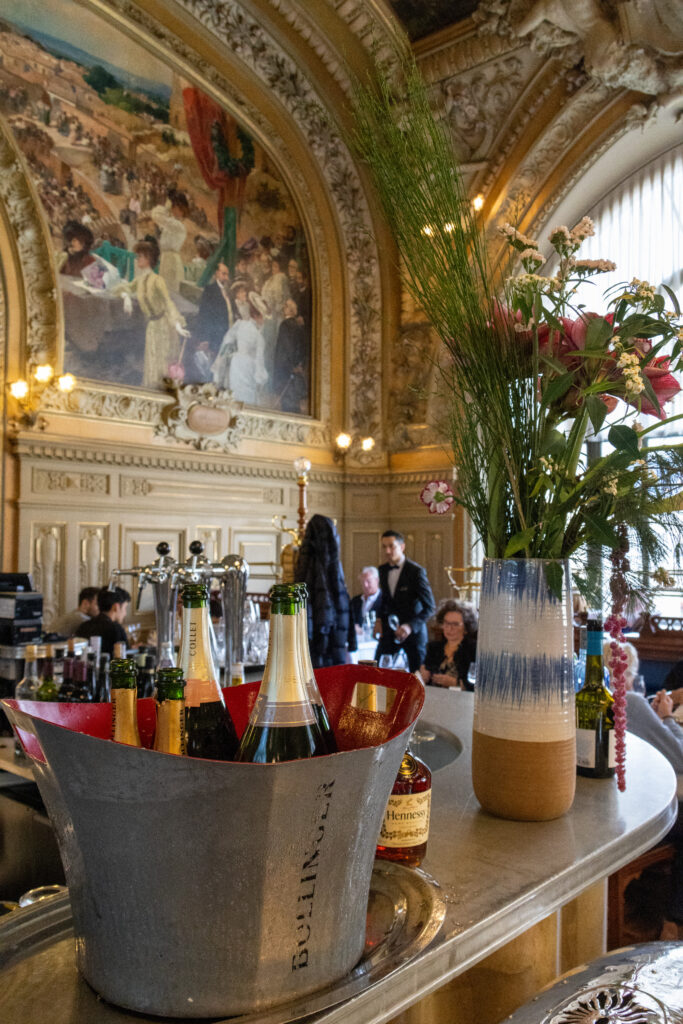
The restaurant was first inaugurated during the Universal exhibition in 1900, which brought international attention to the Art Nouveau style. Those who pass through its revolving doors are often caught by surprise at the drastic difference from concrete slab and iron rails to a golden treasure trove. The decor is based on the 1868 Train Bleu luxury line, which descended from Paris to the Cote d’Azur, chugging along the Mediterranean Sea.
Seating 250, the restaurant pays tribute to the Blue Train’s legendary line with dishes curated by invited Michelin star chefs, inspired by the railway’s former destinations. The Belle Époque folklore is not only found on the plate, but also on the ceiling, with 41 paintings depicting passing French landscapes whilst traveling by train.
Throughout the 20th century, le Train Bleu became a crowd favorite, including for stars such as French actress Brigitte Bardot, designer Coco Chanel, and artist Salvador Dali, to name a few.
Petit Palais
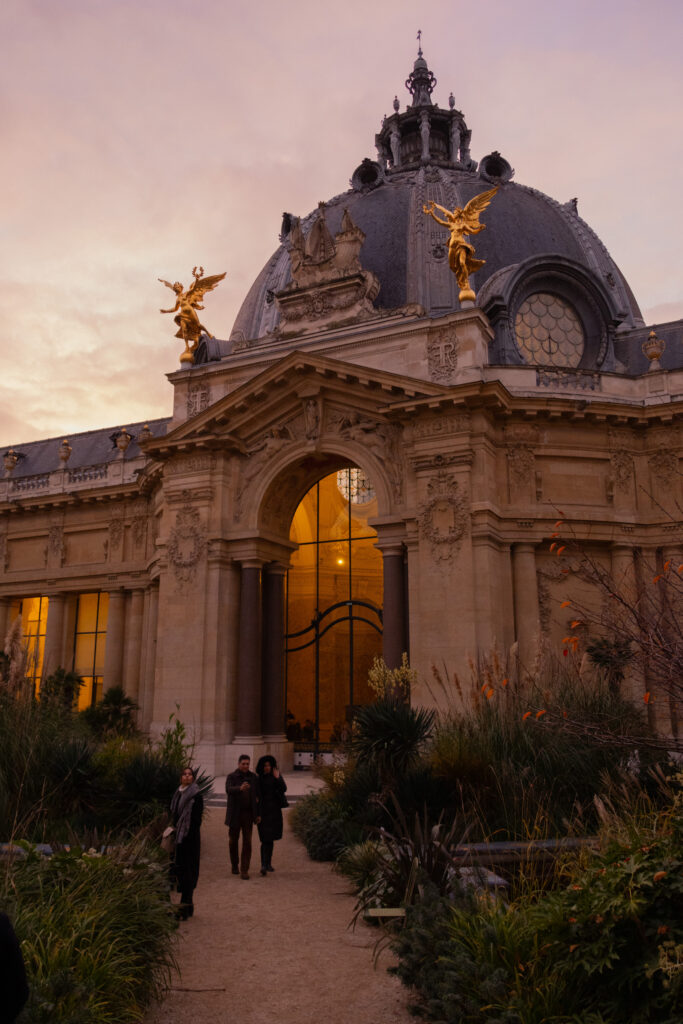

As the sun began to set, I walked through the Petit Palais’s inner horseshoe-shaped courtyard overlooking a small pond surrounded by cattails and trees with harvest moon-colored leaves. The space seemed secluded, hidden beneath the shadows of the high columns keeping the Art Nouveau décor standing.
Opened during the 1900 World’s Fair, le Petit Palais was presented as an ensemble with two additional architectural phenomena: it’s sister the Grand Palais as well as the Pont Alexandre III. The permanent collection is easily visited within an hour, unlike its counterparts the Louvre or Musée d’Orsay, and houses pieces from the Antiquity to early 20th century, including works from French art legends Monet and Cezanne.
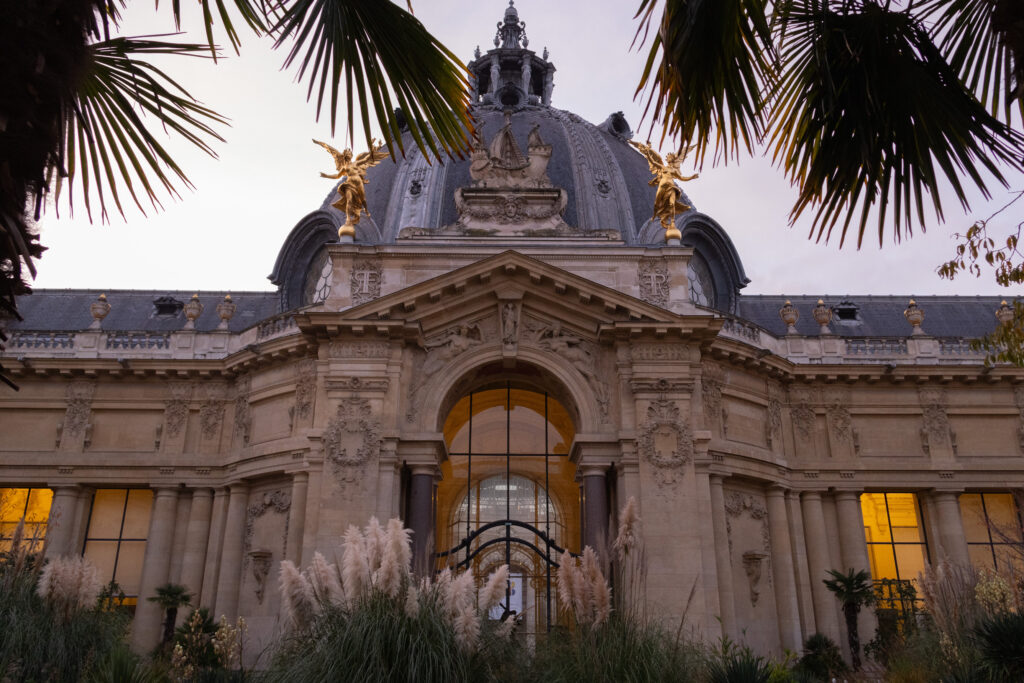
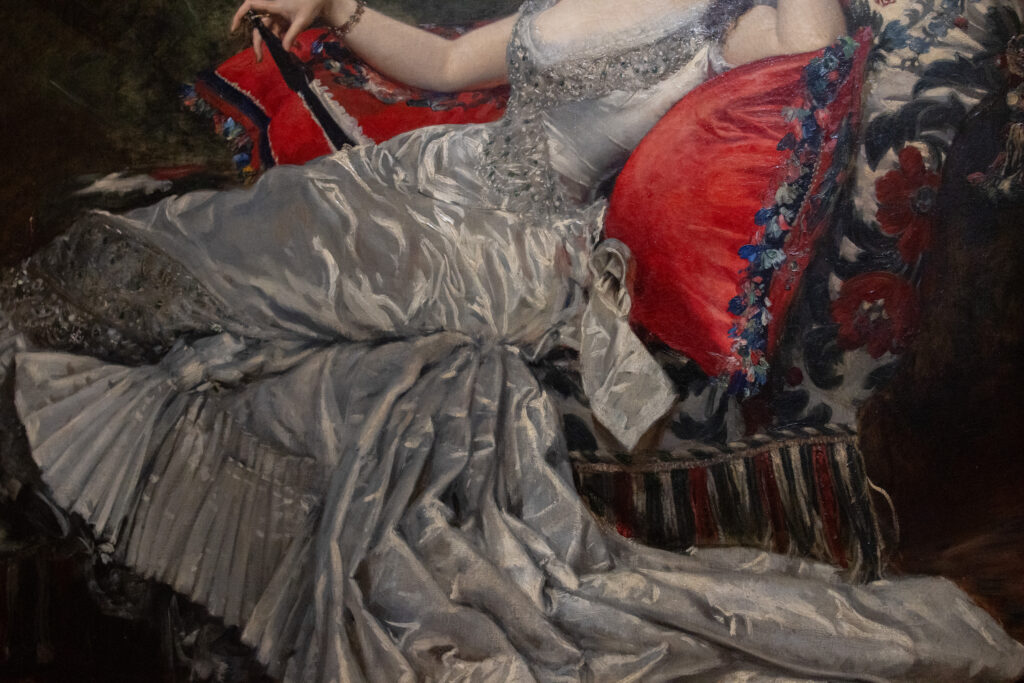
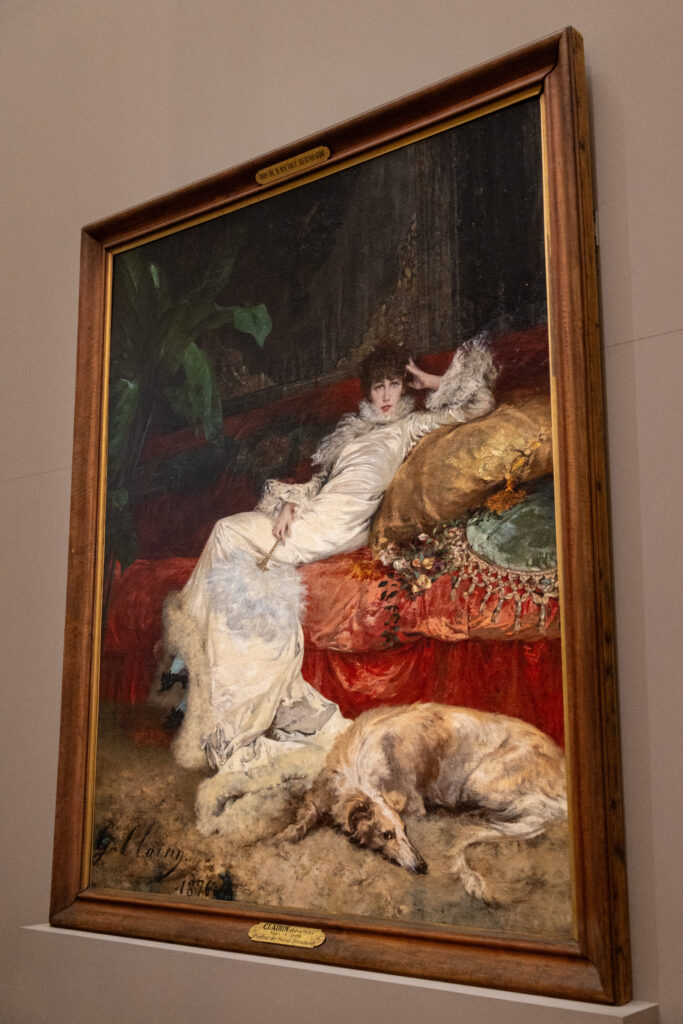

“On dirait toi,” my friend Polina exclaimed, pointing to a portrait of French actress Sarah Bernhardt, painted in 1876 by Georges Clairin. I was drawn to the dark tones and strokes of red and emerald, and to her eyes, so seemingly at ease in the world. Curious about Ms. Bernhardt, I learned that she was the daughter of a courtesan of the upper class, including the Duke de Morny, Napoleon III’s half-brother, who arranged for Sarah to audition for the theater la Comédie-Française. An internet search of the Belle Époque star finds her pictured in a silk coffin, which she bought to sleep in or to practice her roles. She also reportedly purchased exotic animals while traveling, including bears, jaguars, monkeys, and parrots. Her animals were many, just as her lovers. She was the first woman to play Hamlet in 1889, making her a pioneer of the time. Today she is recognized from art-nouveau posters designed by Alphonse Mucha and is considered one of the first examples of an international star.
Le Petit Palais quickly became one of my favorite spots in the city.
- Pajon, L. (2024, September 10). Les bouillons, des bistrots en ébullition. Le Monde.fr. https://www.lemonde.fr/m-styles/article/2024/09/05/les-bouillons-des-bistrots-en-ebullition_6305007_4497319.html ↩︎
